Alex Bledsoe's Blog, page 6
June 19, 2017
Guest blog: Sarah Gailey on Hippos
The premise of Sarah Gailey’s insanely fun new novella, River of Teeth , is that there are killer feral hippos in the Mississippi, and someone has to deal with them. Since I just released a novel that featured killer feral hogs, I loved her idea, and once I read it, I loved it even more. So much so that I asked Sarah to do a guest blog and correct some preconceptions about hippos that we all might share.
###
Q: Are hippos friendly?
A: Hippos are 0% friendly. They are mean and aggressive and do not like to be bothered. Do not bother hippos, because the hippos will bother you back, and they will bring 3000 pounds of bother when they do.
Q: Could a person really ride a hippo?
A: Sure! Hippos have broad backs and a hard time turning their heads very far around. If a person (say, a hippopotamus-riding cowboy) were to raise and train a hippo from a very, very young age, that person could conceivably strap a kneeling saddle to the hippo’s back and ride it in grand style.
Do not try this at home. 3000 pounds of bother, remember?
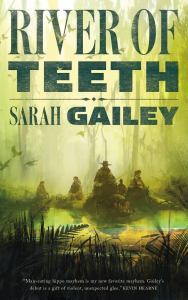 Q: But hippos can’t eat meat, right?
Q: But hippos can’t eat meat, right?
A: Oh, but they can. Biologist Joseph Dudley recorded hippos eating impalas, kudus, wildebeest, zebras, other hippos, and even elephants. And they’re good at it: hippos can take animals down if they’re hungry, or even if it just seems like a ripe opportunity for them to try a taste of wildebeest. They even do it in captivity, seemingly out of boredom — the flamingoes in the hippo pen at the zoo don’t always last long. It’s not great for the hippo’s health, but they do it anyway. A desperate hippo — or even a not-so-desperate hippo — will be more than happy to taste blood.
Q: Oh, shit.
A: Yeah.
Q: But hippos don’t really kill people, right?
A: They kill 2,900 people per year on average. To put that in perspective, about 5 people per year die around the world from shark attacks. About 58 people per year die from bees (I would say ‘bee stings’ but my source isn’t clear on what the bees did. Maybe they had switchblades, I don’t know). So, according to my very scientific math, it would take 10 bull sharks with angry bees shooting out of their eyes to equal the deadliness-quotient of a single hippopotamus.
Q: Oh, shit.
A: I know. Don’t go in the water. Or if you do, wear a beekeeper outfit just in case.
Q: But it’s not like they, um —
A: Yes they do. They do. The thing you are afraid of? They do it. Don’t come at me about hippo biology, I’m ready for you. You have a knife? That’s cute. They have two sets of fighting incisors coming straight out of their face, and those aren’t even the scary teeth.
Q: But what if I —
A: You have a motorboat? Neato. They can run across the bottom of a river at 30 miles per hour. How fast can your motorboat go? How fast can you swim? If it’s slower than 30 miles per hour, you’d better hope that wake in the water is one bull shark with eye-bees coming after you, because if it’s not then you’re hippo-kibble.
Q: Oh no, this hippo is injured! See, he’s bleeding! We should go help him.
A: STOP RIGHT THERE, BUCKO. That’s not blood, it’s blood-sweat. It’s a fine layer of blood-looking mucous that acts as a sunscreen and a natural antibiotic. You can tell it’s not blood because when they have blood on them, it washes off in the water, but the blood-sweat stays put. They often have blood on them.
Q: …What about Fiona?
Don’t let the bubble-chasing fool you. She’s practicing for the day she can finally pursue the most dangerous game: man.
###
 Sarah Gailey is an internationally published author of fiction and nonfiction, and a regular contributor for Tor.com and Barnes & Noble. She tweets @gaileyfrey. Learn more at www.sarahgailey.com.
Sarah Gailey is an internationally published author of fiction and nonfiction, and a regular contributor for Tor.com and Barnes & Noble. She tweets @gaileyfrey. Learn more at www.sarahgailey.com.
June 7, 2017
Win the audio version of Gather Her Round!
So the good folks at Blackstone Audio have sent along a couple of copies of the audio version of my latest Tufa novel, Gather Her Round. Once again it’s read by Stefan Rudnicki, who makes my writing sound at least ten percent better. It’s a $35 value, but you can enter for a chance to win one of them FREE by posting a comment below.
Gather Her Round has, as its villain/monster/McGuffin, an enormous feral hog. It’s slightly larger than life, but not by much, and it embodies a genuine, growing and dangerous problem of wild and feral swine in the Southeast. So to enter this giveaway, tell me in the comments what the strangest animal-related thing you’ve ever seen in the woods.
I’ll start.
I once saw a snake crawl to the edge of a stream, strike out and actually catch a fish.
Good luck!
May 30, 2017
Why I Want WONDER WOMAN to be Awesome
So the advance word on the Wonder Woman film is good, and that’s a relief. I’ve found every other DC movie to be heartless and cruel, so I was seriously concerned that they’d screw this one up as well.
But, as I said, the advance word is good. And that same advance word comes with a now-typical response from crying manbabies about how anything that celebrates women denigrates men. I have no time for that kind of childishness, because I’m concerned about my actual children.
I have two sons, and a daughter. For the most part, we love the current crop of superhero movies, particularly the Marvel films. And while I enjoy them, I do firmly believe that the prime audience for superheroes is and will always be children. The best of these films understand that.
For my sons, I can say, “See? Captain America always sticks to his principles, even when everyone else is against him. Even when his friends are against him, which is the hardest thing of all. Try to do that.”
For my sons, I can say, “See? Thor had to lose his powers and be willing to die for the sake of others before he realized it was important to fight for something, not just fight for the hell of it. Try to do that.”
For my sons, I can say, “See? Peter Parker could have stopped the bad guy, but he didn’t because he was being snotty. And look what happened. He learned from that. Try to be like that.”
(Sorry, DC, but so far none of your superhero movies demonstrate any behavior I’d want my kids to emulate.)
And yes, those lessons apply to girls, too. But there’s something about seeing someone like yourself up there on the screen that resonates. I, and my sons, are lucky: we’re white guys. We have scads of superhero role models, including the three mentioned above.
My daughter, not so much.
Sure, there’s Supergirl on TV, and it’s an okay show with moments of brilliance (the first-season scene where a power-less Supergirl talks a robber into giving up his gun is one of the greatest superhero moments ever, in any format), but no matter how well-done she is, SuperGIRL will always be ancillary to SuperMAN. She was created to be.
No, it’s nice to have a Supergirl, but my daughter deserves a Wonder Woman. All little girls do.
So while I’ll need to see the movie first before deciding if she can watch it (it’s a PG-13 movie, and she is just five), I hope it’s good. Hell, I hope it’s great. Awesome, even. I want her to look forward to seeing it the same way I did Superman: the Movie, or Batman, or even Thor. I want her to see someone up on the screen that she can aspire to, that she can take to her heart and believe, “That’s my hero.”
Yes, hero. Not “heroine.” A hero is a hero, regardless of gender.
And I want my daughter to have one.
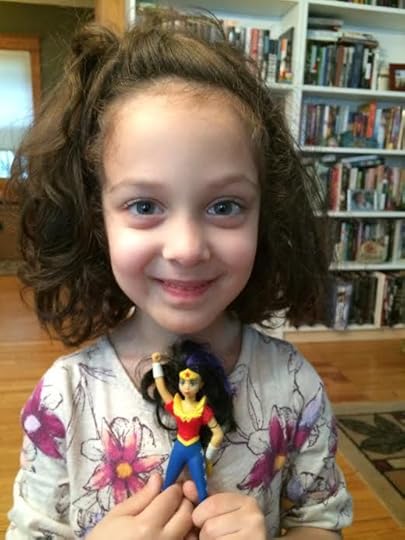
May 1, 2017
Cover reveal for The Fairies of Sadieville
Here we go: the cover for the sixth Tufa novel, The Fairies of Sadieville. This cover was designed by Jamie Stafford-Hill under the supervision of Irene Gallo, and in my opinion they’ve really outdone themselves. All the Tufa novel covers have been gorgeous (in my opinion), and this one is no exception. It also depicts a moment from the story, which to me makes it even more meaningful. I hope you like it, and the book when it comes out next year.
Let me know what you think of the cover in the comments.
April 29, 2017
A Special Offer for Independent Bookstore Day
In honor of Independent Bookstore Day, here’s some incentive to get out and visit your local indie store today: if you buy one of my books from an indie and send me a photo of the receipt, I’ll send you a signed copy of another of my books.
Indies are the people who are in it for the love, and they deserve our appreciation. So go find one today!
April 24, 2017
The Same River Twice: Tender Mercies and Crazy Heart
Recently I finally caught Jeff Bridges’ Oscar-winning performance in Crazy Heart. And while he was certainly very good, I couldn’t shake the sense that I’d seen this movie before, when it starred Robert Duvall and was called Tender Mercies. Naturally, I’m not the first viewer to notice that.
The similarities are striking. Even the protagonists’ names are similarly short, sharp, and masculine: Bridges plays Bad Blake, Duvall plays Mac Sledge. Both are middle-aged country singers struggling with alcohol and careers on the skids. Both actors do their own singing. Both characters become involved with single mothers of young sons. Both singers are estranged from their adult children. Both face a crisis involving a child. And both men won Oscars for their roles.
But though both tell essentially the same story, the emphasis is completely different.
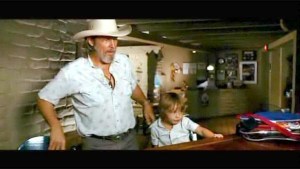 In Crazy Heart, we follow Bad Blake on his long slide down, knowing that eventually his drinking will lead to tragedy of some sort. We wait for him to bottom out, dreading it and yet anticipating it, because without it the story has no point. When it finally happens, we’re almost relieved. Then in the last few minutes there’s the sobriety montage, the amends-making, and the return to performing. Ironically, Bad turns to a friend, played by Tender Mercies star Duvall, to help him get sober.
In Crazy Heart, we follow Bad Blake on his long slide down, knowing that eventually his drinking will lead to tragedy of some sort. We wait for him to bottom out, dreading it and yet anticipating it, because without it the story has no point. When it finally happens, we’re almost relieved. Then in the last few minutes there’s the sobriety montage, the amends-making, and the return to performing. Ironically, Bad turns to a friend, played by Tender Mercies star Duvall, to help him get sober.
 In Tender Mercies, on the other hand, Mac Sledge bottoms out before the credits finish. Because this film was written by a master of understatement, the great Horton Foote, it’s not nearly as dramatic (or rather, melodramatic) as Bad Blake passed out on his bathroom floor in his tidy whities. But the bulk of the film is about Mac Sledge, as one reviewer put it, “coming back, but only as far as he wants to.”
In Tender Mercies, on the other hand, Mac Sledge bottoms out before the credits finish. Because this film was written by a master of understatement, the great Horton Foote, it’s not nearly as dramatic (or rather, melodramatic) as Bad Blake passed out on his bathroom floor in his tidy whities. But the bulk of the film is about Mac Sledge, as one reviewer put it, “coming back, but only as far as he wants to.”
So in simple terms, Crazy Heart is about Bad Blake’s fall. Tender Mercies is about Mac Sledge’s rise.
Alice Walker called her book about turning The Color Purple into a movie The Same River Twice. To extend that metaphor to this example, imagine the almost identical story of both films as a single river; where the journey starts on it depends on where you put in your boat. Crazy Heart puts in far upstream from Tender Mercies, but stops just past the point the earlier film begins. And Tender Mercies continues on far past the end of the other film.
I confess a preference for Mac Sledge’s journey, and not just because Horton Foote is a better screenwriter than Scott Cooper. Bad Blake travels the same well-worn path found in films like Walk the Line, except that the upbeat conclusion of Bad’s story rings false, somehow (and is entirely different from the downbeat ending of the source novel). In real life, people as far gone as Bad Blake—people like Kurt Cobain, Jim Morrison, Ian Curtis, Janis Joplin, Amy Winehouse—don’t turn around, or if they do, they’re shadows of their former selves. You dance with the devil, the devil doesn’t change, you change.
Mac Sledge, on the other hand, doesn’t want his old life back. He’s done with the music business, if not with music. He wants, not just a better life, but a different life. This is explicit in probably the most famous exchange from the film, when a woman at the grocery store asks. “Hey, mister, were you really Mac Sledge?” He replies, with dry irony, “Yes, ma’m, I guess I was.”
It’s an entirely personal preference, of course. Both films are solid, and both feature great performances. So where you put in your boat is, I guess, dependent upon what part of the river you want to travel.
April 17, 2017
What If It Were Me? Finding the Right Ending
Recently a fan posted this statement on my Facebook page:
My wife and I have now both finished Gather Her ‘Round and find ourselves wondering if the Tufa ever get a HAPPY ending?
I replied,
I can’t speak to that (we all have our definitions of “happy”) but I hope they all have the right endings for those particular stories.
I wanted to expand a little on what makes the “right” ending.
Consider the Shakespearean definition of a tragedy: the story of a seemingly heroic figure whose major character flaw causes the story to end with his tragic downfall. What this means, in practice, is that in a Shakespeare play, the story ends the only way it can. Hamlet, Lear, Macbeth, Othello, are all dead by the end of their plays, along with most of the rest of the cast, but it’s not depressing because it feels like the right ending. Hamlet’s indecision, Lear’s pettiness, Othello’s jealousy all set the characters, and their stories, on a path that, when it concludes, feels inevitable. They called it catharsis in my high school English class; a more prosaic term might be that the ending makes us inevitably wonder, what if it were me?
Imagine if Hamlet had avoided the poisoned blade, exposed Claudius, and taken over as king; or if Othello realized he’d been duped by Iago before he killed Desdemona. Would we still be talking about these characters five hundred years later? Would we see ourselves in their bad decisions, the way we do now? Because that’s what the right ending does: it makes you realize that the story could have been about you. What if it were me?
As an example of a notoriously wrong ending, consider the original final scene of Blade Runner. After finding the origami unicorn (you’ll have to see the film to understand the meaning), Deckard and Rachel go into the elevator. The doors close, and the screen goes black.

And then, after we’ve spent two hours learning that the earth of 2019 is so ravaged that people are leaving in droves, after seeing that there are virtually no real animals left, just artificial copies, after the heartbreaking scene in which Roy Batty, an artificial human, shows more humanity than any of the human characters…suddenly Deckard and Rachel are driving somewhere with sunlight dappling through green trees. Deckard informs us that, unlike every other Nexus 6 with a four-year life span, Rachel is “special” and has no preset termination date. Not only does this ending wreck the story thematically, it makes absolutely no narrative sense. It contradicts everything the rest of the movie has gone to great lengths to establish.
The right Blade Runner ending is the one found on the director’s cut, ambiguous in its meaning and asking more questions than it answers. And like every good ending, it’s encoded in the story’s narrative DNA from the first scene. When the last revelation hits, we wonder, what if it were me?
So I didn’t set out to write a “happy” ending, or a sad one, or a funny one for Gather Her Round. I set out to write the right ending. Every story has one, and the writer’s job is to figure it out. If s/he does, then the reader will (hopefully) see him/herself in the characters, and wonder, what if that were me?
April 10, 2017
Guest post: Robyn Bennis on the Uselessness of Writing Advice
I firmly believe that all good writing advice is generalized to the point of uselessness by its third retelling.
You know the sort of advice I’m talking about. It takes the form of the tired maxims your critique group can’t stop themselves from repeating, the literary platitudes from a once-great author whose work began to flag about the time they started handing out literary platitudes, and the pithy dictums around which entire advice books are written—advice books which spend most of their length trying to backfill their pithy dictums with common sense.
Why don’t rules and maxims produce better writing? The answer can be found at the heart of every romcom and uplifting Disney movie you’ve ever seen: you are one of a kind. Except, this time it’s actually true! Your writing is a unique and special thing, even if it’s terrible. That may sound mean-spirited, but I’m serious. Your crappy writing is still one of a kind, which is why it won’t get noticeably better after you take out every other adverb, apply some paint-by-numbers plot structure to your trite story concepts, or force the inane thoughts of your paper-thin characters into a rigidly limited point of view. (Okay, that last one really was mean-spirited, but don’t expect an apology.)
Simply put, no writing advice is universal. The deeper secret hiding behind every “secret of writing” is knowing when to apply that secret. If you don’t, no pithy dictum can improve your work, because you’re just painting over rotten wood.
 So how do we know when to apply generalized advice to the special snowflake that is our own writing? I’m sorry to inform you that the only solution is deliberate, critical analysis and honest self-reflection. Yeah, I know; that’s the sort of garbage you were trying to get away from when you started writing, but you’ll just have to endure it a little longer.
So how do we know when to apply generalized advice to the special snowflake that is our own writing? I’m sorry to inform you that the only solution is deliberate, critical analysis and honest self-reflection. Yeah, I know; that’s the sort of garbage you were trying to get away from when you started writing, but you’ll just have to endure it a little longer.
You can take the first step by reading constantly. Read broadly in genre but selectively in quality. Read something from every nook and cranny of the literary universe, as long as it isn’t crap. Over time, you’ll develop an almost instinctual sense for what works and what doesn’t.
With this reservoir of common sense to draw on, you’re ready to start thinking about how both general writing advice and individual critiques apply to your own writing. This is the time to join a writing group, if you haven’t already. You’ll find personalized critiques infinitely more valuable than entire volumes full of advice books.
Or you will, if you take the time to analyze the root of those critiques. This is the most important and perhaps the most commonly botched step in becoming a better writer. Many budding wordsmiths examine a critique of their writing, correctly recognize that the reader has found a flaw, and make the critical mistake of taking their advice on how to fix it. Do not fall into this trap. Unless your critique partner knows your voice inside and out, their advice is probably too generalized to be of use to you. Instead, you’ll thank your wonderful critique partner, who has done you such a service in giving you an opportunity to improve yourself, and then ignore them. At least, you’ll ignore their proposed solution. Instead, you’ll go off, think about the root of the problem, and find a solution that works for you—a solution that fits your voice and style.
If this seems like a lot of work to fix one little flaw in one little story, or if you’re casting longing glances at that shelf full of advice books and their promise of easy solutions, remember that you’re in this for the long haul. You’re not just correcting flaws in a story, but flaws in a writer, and there’s no secret shortcut for that. You simply have to build up the writer within that mortal shell, piece by piece, year by year, until your unique voice comes through.
 Robyn Bennis is an author and scientist living in Mountain View, California, where she consults in biotech but dreams of airships. The Guns Above is her debut novel.
Robyn Bennis is an author and scientist living in Mountain View, California, where she consults in biotech but dreams of airships. The Guns Above is her debut novel.
April 3, 2017
The Heat from the Story Fire
As I’ve said before, I’m a Shakespeare fan. I mean that literally: I feel the same mix of affection and excitement that I do for James Bond, Star Trek, Godzilla and Dracula. I obsess over the minutia, watch my favorite “episodes” (plays) over and over, and collect things that have meaning for me as a fan.
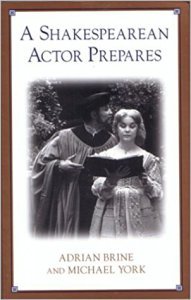 And although I’m no scholar, I love reading scholarly stuff. Lately I’ve been working my way through A Shakespearean Actor Prepares, by director Adrian Brine and actor Michael York. All the intellectual dissection in the world, to me, doesn’t stack up to the thoughts of the people who have to get out there in public and bring these things to life.
And although I’m no scholar, I love reading scholarly stuff. Lately I’ve been working my way through A Shakespearean Actor Prepares, by director Adrian Brine and actor Michael York. All the intellectual dissection in the world, to me, doesn’t stack up to the thoughts of the people who have to get out there in public and bring these things to life.
And on page 278, I ran across this brilliant description of how actors should approach playing supporting characters:
Let us imagine the central action of the play (Macbeth’s regicide, or Antony’s obsession with the Queen of Egypt) as a great fire: It scorches the people involved, but even those standing far off feel the heat on their faces, and are upset by it…The actor needs to look around not for a “character” to play, but for an emotional reaction toward the central action, or the “fire.”
Think about the movie Jaws. Every single scene, whether on the ocean or in Chief Brody’s kitchen, is ultimately about the shark. The shark is the fire, and it scorches our three heroes (and utterly consumes one). But Mayor Vaughn and Ellen Brody also get singed, and beyond them, the citizens of Amity Island all feel the heat.
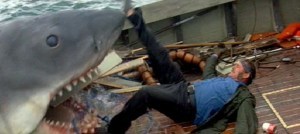
Quint being consumed by the “fire” in Jaws.
There’s a personal irony in this observation, too. For over twenty years, when I’m having trouble getting into the right mind-set to write, I’ve recited this, the opening lines of Henry V:
Oh, for a muse of fire
That would ascend the brightest heaven
Of Invention.
So I’d like to think I knew this implicitly, even if I couldn’t describe it with such eloquence. But I can’t swear to it. If I went back and reread my books, I’m sure I’d find many examples of supporting characters totally divorced from the central “fire” of the story. But going forward, I’ll know to look for that fire, and figure out who gets singed, who gets burned, and who gets consumed.
March 27, 2017
Giants of West Tennessee: An Interview with Memphis’ own Southern Avenue
NOTE: This is the latest in an ongoing occasional series about notable figures from my home region. This one is unique because, instead of a nostalgic look back, it’s about something brand new.
This interview needs two introductions to set up the context.
Number one: when I was growing up, WHBQ-AM out of Memphis was the radio station, a Top 40 melting pot that played anything if it was popular. So it was possible to hear, say, Kool and the Gang’s “Jungle Boogie,” followed immediately by “You Light Up My Life,” followed by Jim Stafford’s “Spiders and Snakes.” As a result, its listeners discovered whole genres of music they might never have otherwise. To have that same effect now, in this niche-market world, you have to really go search for things. It’s no longer serendipity, it’s a treasure hunt.
Which leads to…
Number two: I stumbled across Southern Avenue on one of those treasure hunts. The first thing I saw was a clip of the band playing “Don’t Give Up,” the first track of their debut album. I was intrigued by their Memphis origin, and unique visual lineup: five people, three black, two white, two women, three men. They had a girl drummer, a singer who owned the stage, and a sound I hadn’t heard since those days of WHBQ: unashamedly joyous soul. Plus they were signed to the legendary Stax label.
You can find out the band’s background here, but the story is in the music. So check out the clips along with the interview below, and at the end, leave a comment for a chance to win a copy of their CD.
One of the things I really like about your new album is something I loved from the funk and soul I listened to as a kid: it doesn’t wallow in rage or anger, but instead exhorts us to stay strong, find love, dance instead of cry. Was that a deliberate choice?
Thank you for noticing that. Yes, it’s always in our mind. Life is so short and we get only one try. Music for us is a language that connects people together and through our art we manage to touch people and make them feel belonging, loved, and excited. That is a true blessing.
An aspect of the band that fascinated me when I first ran across you online was the mix of gender, race, and nationality. That’s such a powerful statement in these dark, divisive times. How have audiences responded to that?
We don’t think about it, really. We just love each other and love working together. At our shows you will find people of all ages and cultures. We hope our music will bring people together in a way that inspires them.
Ori, I grew up close to Memphis, so for all its cool stuff, it was still just the city down the road. It wasn’t until I got some distance, both in age and geography, that I really appreciated it. Coming from a different culture, what did it represent to you?
Growing up, I listened to a lot of Memphis music, Muscle Shoals, and Motown. I really love blues and jazz. I’ve been listening to Stax records since I was 8 years old. So I’m kind of living my childhood dream. Memphis, just like Israel, is a place where you have to work hard and be the best at your craft if you want to succeed. It is a cultural center geographically and has a long history. So I can really relate to the vibe here. I’ve become a better person and musician since I moved here, 4 years ago.
Tierinii and Tikyra, as Memphis natives, when did you become aware of the musical history around you? And how did it feel to realize you could become part of it?
Even before we signed with Stax, Memphis has showed us a lot of love. People here really want to see us make waves and want us to represent the city well when we are on the road. And we make sure we always do.
How has the city in general, and the music crowd specifically, responded to you?
The history of the music of Memphis is something we learned about through school, but as we got older we understood the meaning and the feeling behind the music. To be a part of it, to have something we created become a part of a legacy, that’s the best feeling in the world. The city has been extremely supportive and loving; it feels like we are all a part of something great and momentous.
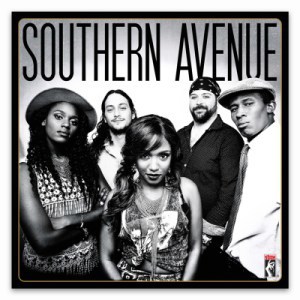
Thanks to Southern Avenue for taking time to answer these questions. If you’d like a chance to win a copy of their CD, leave a comment about your favorite soul band, artist, or song.



